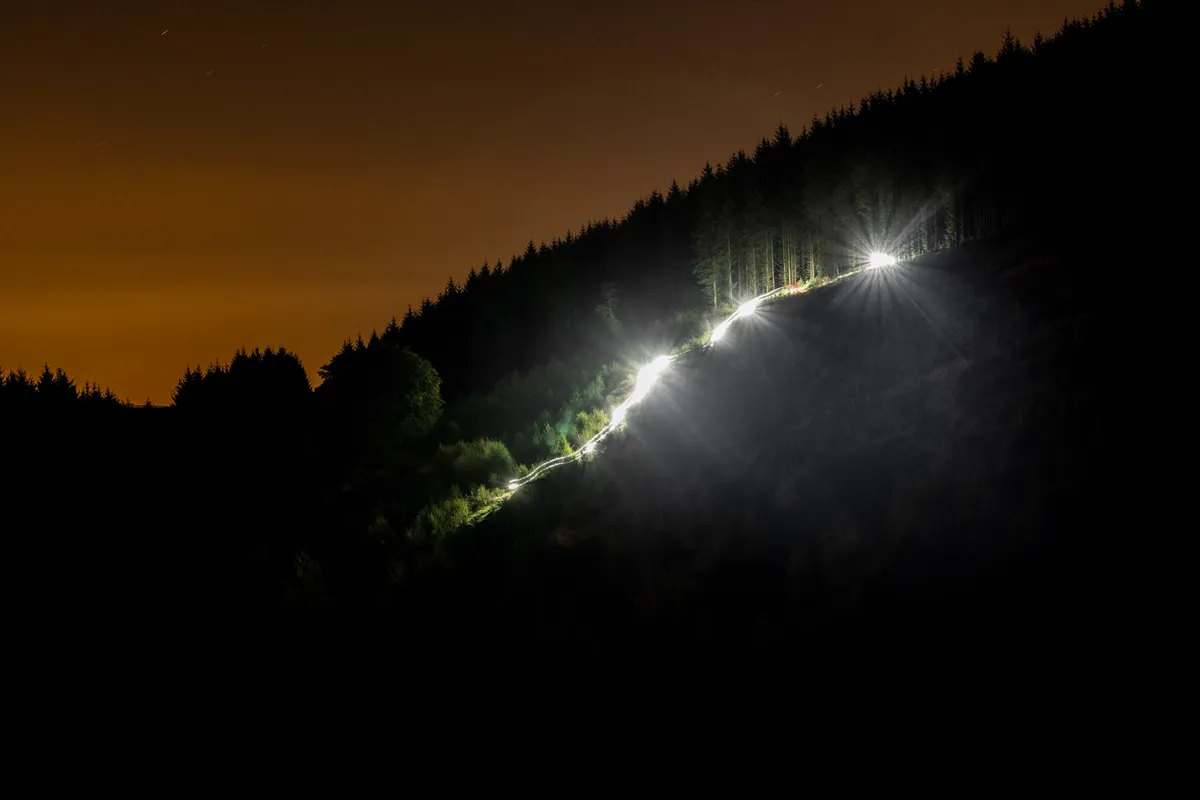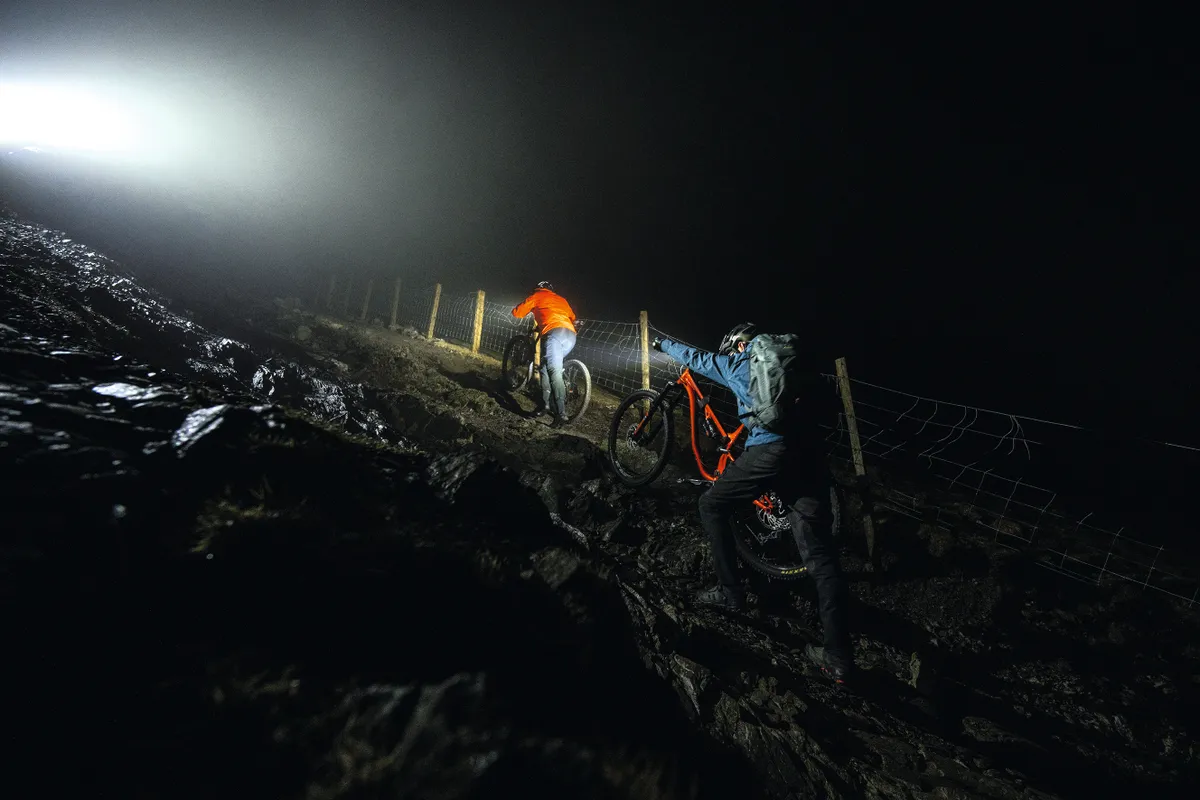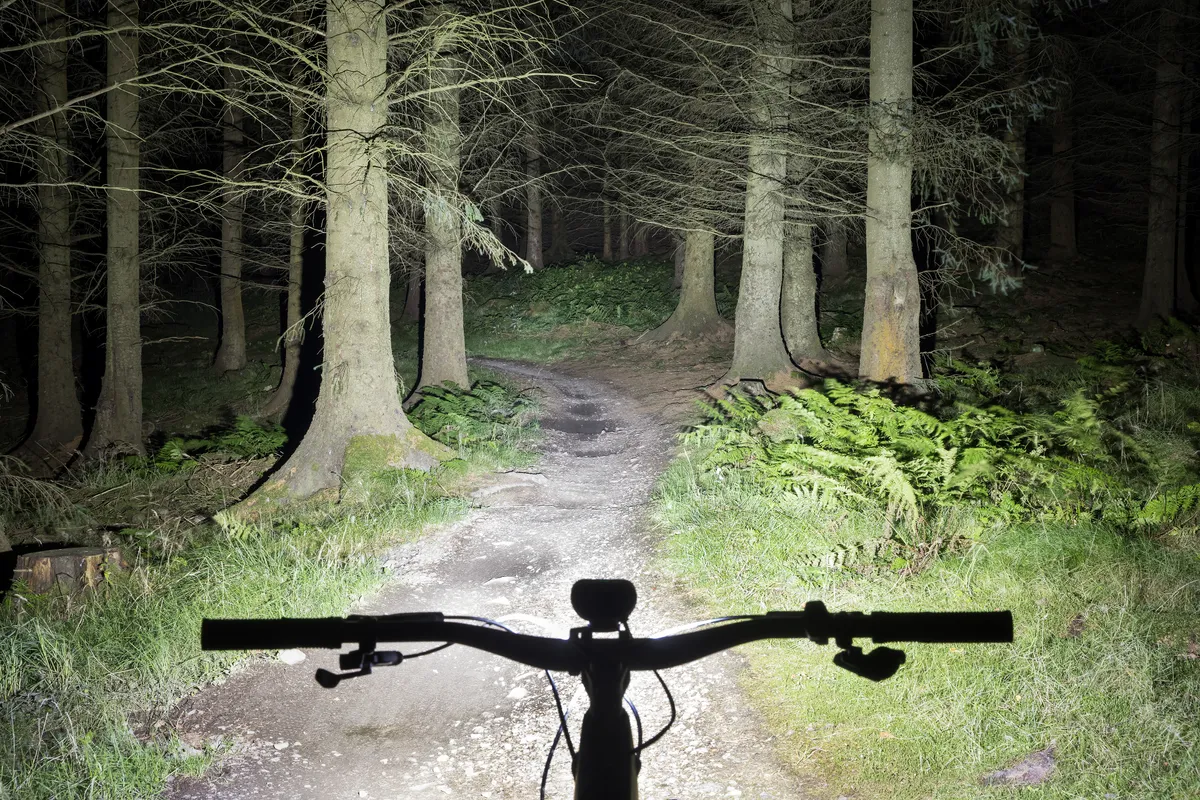Mountain biking at night can be some of the best, most entertaining riding you’ll ever do. With a good crowd, there’s always fun and chaos, plus the dark brings a whole new lease of life to familiar trails.
However, your enjoyment – and your safety – depends entirely on one thing: how well you can see.
It’s easy to underestimate how important picking the right light is. It’s tempting to grab a budget 1,000-lumen light, strap it to your bar and think you’re set.
Then, 10 minutes into the darkness, you’re riding beyond the light’s capabilities, straining your eyes to pick lines and wondering why night riding feels sketchy instead of exhilarating.
As an experienced night rider, and having recently tested six lights, covering a wide range of prices and brands, I can say confidently that lights are one of the rare accessories where spending more pays off.
That’s not always the case with mountain bike tech.
It’s doubtful the inverted Fox Podium fork (£2,199) offers a 65 per cent increase in on-trail performance compared to the Fox 38 Performance Elite (£1,339) for example. Similarly, the Giant Reign Advanced Pro 0 is more than two and a half times more expensive than the Reign Advanced Pro 2 – yet there’s no way you could ride the Pro 0 twice as fast.
However, lights are one of the rare exceptions where this isn’t the case – spending more on a high-quality setup amplifies the real-world return, with better power, safety, confidence and a much better night-riding experience.
- 13 best mountain bike lights in 2025 for night riding, tried and tested
- Riding at night can change your whole perception of mountain biking – here are my tips
Putting my money where my mouth is

I put this theory to the test, taking two sets of lights – a handlebar light paired with a helmet light in both cases – to the woods to compare a budget setup to a premium one.
The first pair – a Knog Blinder X 2300 bar light and a Moon Rigel Max 1500 used as a helmet light – cost a total of £334.99, with a combined maximum output of 3,800 lumens.
The more expensive set was a Magicshine Monteer 6500S Galaxy V2 bar light and Magicshine Monteer 3500 helmet light, giving me a maximum output of 10,000 lumens for £479.98.
From the off, the difference was huge. For an extra £145 – a 43 per cent increase in cost – you gain 263 per cent more lumens, adding an extra 6,200 lumens of usable light.
The 3,800-lumen pairing – which is comparable to many decent mid-range bar and helmet setups – was by no means bad, enabling me to ride confidently on smoother or slower trails.
The beam gives a workable tunnel of light ahead, but it’s still limited in reach and spread. Corners appear more suddenly, roots vanish into shadow, and small trail details get lost in the dim light. I was often left reacting rather than anticipating, meaning I missed lines and flow was hindered.

It’s still fun, but there’s a ceiling on how fast and fluidly you can ride. Fatigue also creeps in faster because your eyes and brain are working overtime to interpret what they can’t quite see clearly.
Step up to 10,000 lumens and everything changes.
Rocks, roots and ruts stand out, and you can see far enough ahead to ride proactively, not reactively.
Corners flow instead of surprising you. You start using the whole trail again – pumping, hopping and carrying speed. The broader beam removes tunnel vision; peripheral light shows the trail’s shape and texture, helping you spot smoother lines and avoid last-second corrections.
It’s not only faster, it’s calmer. It’s easier to stay relaxed, movements are less tense, and your riding feels more natural, confident and controlled.
Bang for your buck

The on-paper difference in performance claims between budget and premium lights is stark. Entry-level lights in the £40 to £80 range typically have claimed power of around 500 to 1,500 lumens, but those numbers can be exaggerated, generally quoting theoretical LED output rather than real-world brightness.
Once you factor in poor heat management, weak drivers and battery sag, those 1,500 lumens can drop significantly on the trail.
However, spend double, and you’ll often get more than double the usable output. Quality systems in the 2,000 to 5,000-lumen range deliver genuine, sustained brightness through better LEDs, efficient circuitry and smart thermal control.
You’re not only buying lumens – you’re buying consistent performance for the whole ride.
Top-of-the-range lights can cost nearly £500, and feature a whole host of extras such as mode programming, app connectivity, remote switches, thermal/boost modes, intelligent sensors and replaceable parts. These features cost more, but can deliver better user experience and future-proofing.
I would certainly look at Magicshine’s range of lights, such as its Monteer 12000 and Monteer 8000S Galaxy V2.0 Remote reviewed here.
Why quality matters

Beam quality matters as much as brightness. Premium lights use precision optics rather than reflectors to balance flood and spot patterns, giving a smooth pool of light that reveals texture without harsh shadows. A well-engineered 2,000-lumen light can outperform a 5,000-lumen budget one.
Within reputable brands, higher prices usually mean more output and better beam shaping – giving you greater depth perception and confidence when speed picks up.
Battery performance is another major difference. Cheap lights fade fast, with exaggerated claimed runtimes, and use low-capacity cells.
Quality models feature larger, regulated lithium packs that hold steady brightness and taper gradually when low.
Add in weather-sealed connectors, solid mounts and accurate battery indicators, and you get a more reliable light you can trust in any conditions.

While cheaper initially, budget lights might end up in landfill after a winter or two thanks to corroded mounts, broken switches and swollen batteries.
That false economy adds up quickly. If you ride regularly, you’ll spend less in the long run by buying a solid setup once instead of replacing bargain options every year.
Ultimately, better lights deliver confidence and longevity. They illuminate the trail clearly, survive years of abuse, and come with spares and warranty support. In the dark, your light is your ride – and when it comes to seeing and surviving the trail, over and again, quality is king.
Light at the end of the tunnel

Night riding can be one of the best parts of mountain biking. It turns familiar trails into something new – a mix of focus, adrenaline and entertainment that’s hard to find anywhere else. But that experience depends entirely on visibility.
Skimp on lights, and you’re limiting what you can see, how fast you can go and how much fun you can have. Spend a bit more, and you unlock the full enjoyment of riding in the dark – with clarity, confidence, and flow.
Sure, lumens aren’t everything. But when those lumens are real, consistent and paired with quality optics, more is almost always better. So if you’re weighing up your next purchase, here’s the bottom line: more money often disproportionately amplifies the experience.




